Dive into the heart of the untouched and enigmatic landscapes of Nepal with Restricted Area Trekking, an exclusive adventure into regions safeguarded by the government for their ecological, cultural, and geographical significance. These areas, including the ancient kingdoms of Upper Mustang, the remote valleys of Dolpo, and the spiritual sanctuaries of Manaslu, Tsum, and Nar Phu, offer an immersive experience into the pristine beauty and rich heritage of the Himalayas. Accessible only with special permits through registered trekking agencies, these treks are not just journeys through rugged terrains but a deep dive into the traditions and lifestyles preserved away from the modern world, ensuring every adventurer leaves with profound memories and a deeper understanding of Nepal's hidden treasures.
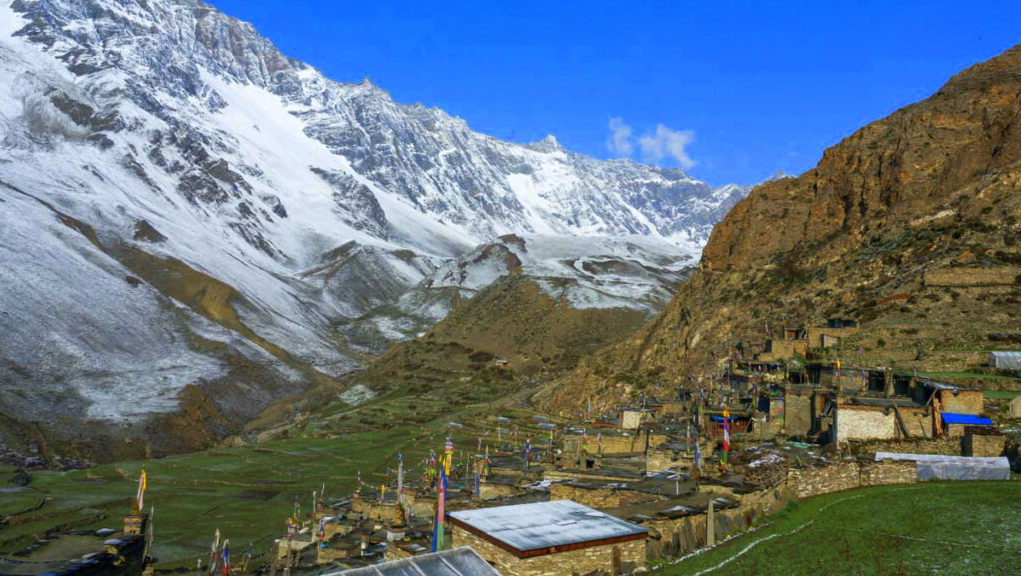
Luxury Holidays Nepal Pvt. Ltd. stands out as the go-to company for Restricted Area Trekking in Nepal, offering unrivaled access to the country's most secluded and mesmerizing regions. Our expertly crafted tours to places like Upper Mustang, Dolpo, Manaslu, Tsum Valley, and Nar Phu Valley promise an exclusive peek into the hidden wonders of the Himalayas. With special permits, experienced guides, and a deep respect for local cultures and environments, we ensure a seamless and enriching trekking experience. Choose Luxury Holidays Nepal for an unforgettable journey into Nepal's protected paradises, where adventure meets heritage in perfect harmony.
Upper Mustang
Upper Mustang, often referred to as the "Last Forbidden Kingdom," is a mesmerizing region in Nepal that offers a unique blend of natural and cultural treasures. Located in the rain shadow of the Himalayas, it is distinguished by its desert-like landscape, deep canyons, and unusual rock formations, presenting an otherworldly beauty that contrasts sharply with the lushness typically associated with Nepal.
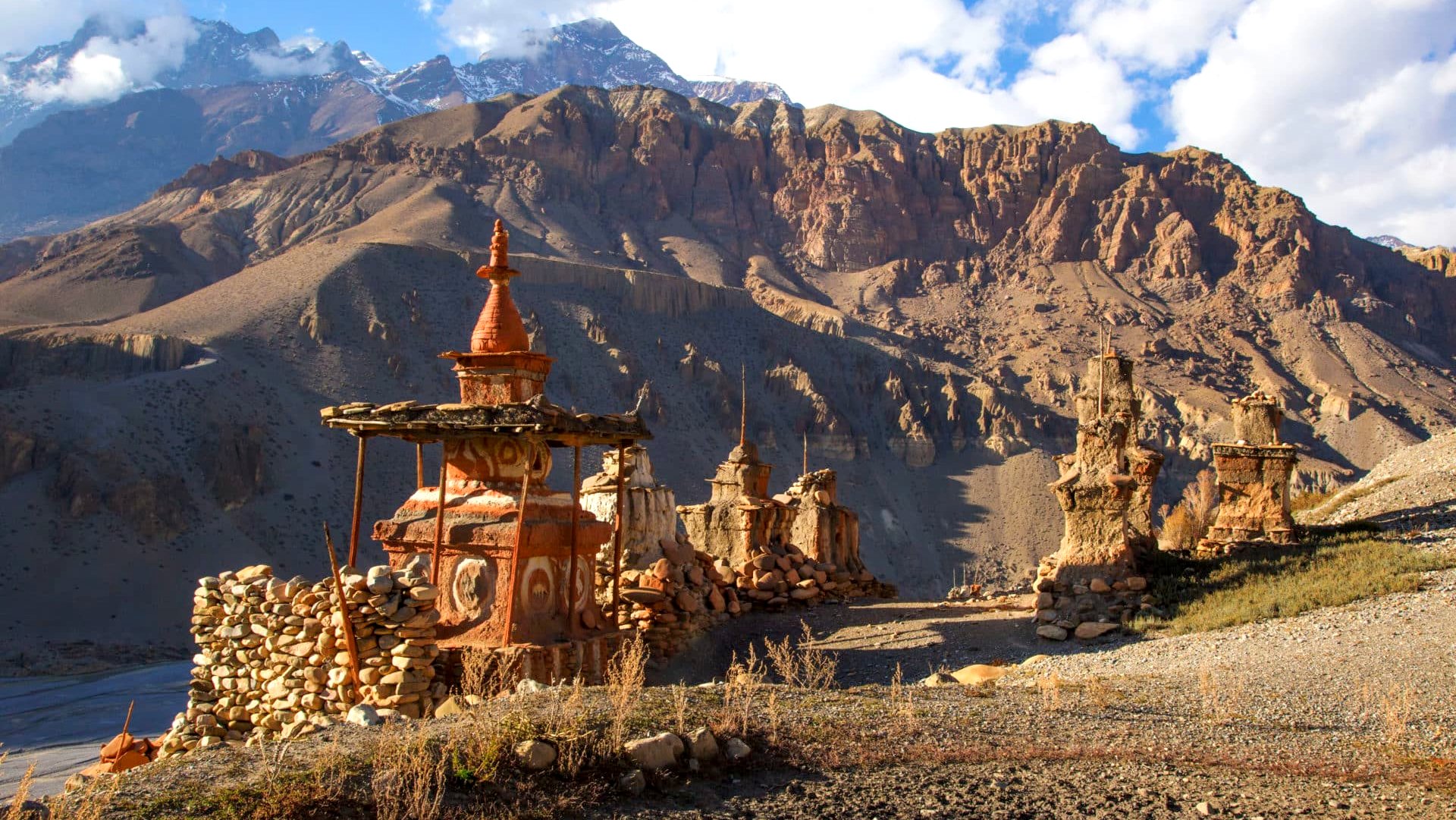
Highlights of Upper Mustang:
- Lo Manthang: The historical capital of Upper Mustang, Lo Manthang, is a walled city that has preserved its ancient Tibetan culture, architecture, and religious practices. It serves as a living museum where time seems to stand still.
- Ancient Monasteries: Upper Mustang is home to several ancient Tibetan Buddhist monasteries, including the 15th-century Thubchen Gompa and the Ghar Gompa, which are adorned with beautiful frescoes and house precious religious artifacts.
- Royal Palace: The Royal Palace in Lo Manthang is a significant cultural landmark, offering insight into the history and heritage of the Mustang Royalty.
- Challenging Terrain: The trek to Upper Mustang involves traversing arid, desert-like landscapes with deep ravines and rock shelves, set against the backdrop of majestic mountain peaks.
- Tiji Festival: This annual festival in Lo Manthang is a vibrant celebration featuring traditional Tibetan dances, music, and religious ceremonies, drawing visitors from around the world.
- Archaeological Sites: The region is dotted with ancient cave systems, some of which contain centuries-old murals and artifacts, offering a glimpse into the area's rich history and pre-Buddhist cultures.
Importance of Upper Mustang: Upper Mustang is not only significant for its stunning natural landscapes but also as a bastion of Tibetan Buddhist culture. The area was restricted to outsiders until 1992, helping preserve its unique heritage and traditions. Today, it remains a restricted area, requiring special permits to visit, which helps manage tourism impact and preserve its cultural integrity and natural beauty.
Trekking Experience: Trekking in Upper Mustang is an experience unlike any other in Nepal. It offers an opportunity to step back in time and explore a landscape and culture that has remained largely unchanged for centuries. The journey is both physically challenging and spiritually rewarding, offering breathtaking vistas, intimate cultural exchanges, and a profound sense of tranquility and timelessness. Trekkers need to be prepared for the high altitude and the arid conditions, but the rewards of such an adventure are immeasurable, offering a deep connection with nature and a rare insight into the enduring cultural legacy of the Himalayas.
Manaslu Circuit
The Manaslu Circuit Trek is a spectacular journey that encircles the majestic Manaslu, the world's eighth highest mountain, standing at 8,163 meters (26,781 feet). This trek, located in the heart of the Nepalese Himalayas, is celebrated for its breathtaking landscapes, diverse ecosystems, and rich cultural experiences. It traverses through remote villages, lush forests, and high alpine environments, offering trekkers an authentic insight into the lives of the people residing in the shadow of Mt. Manaslu.
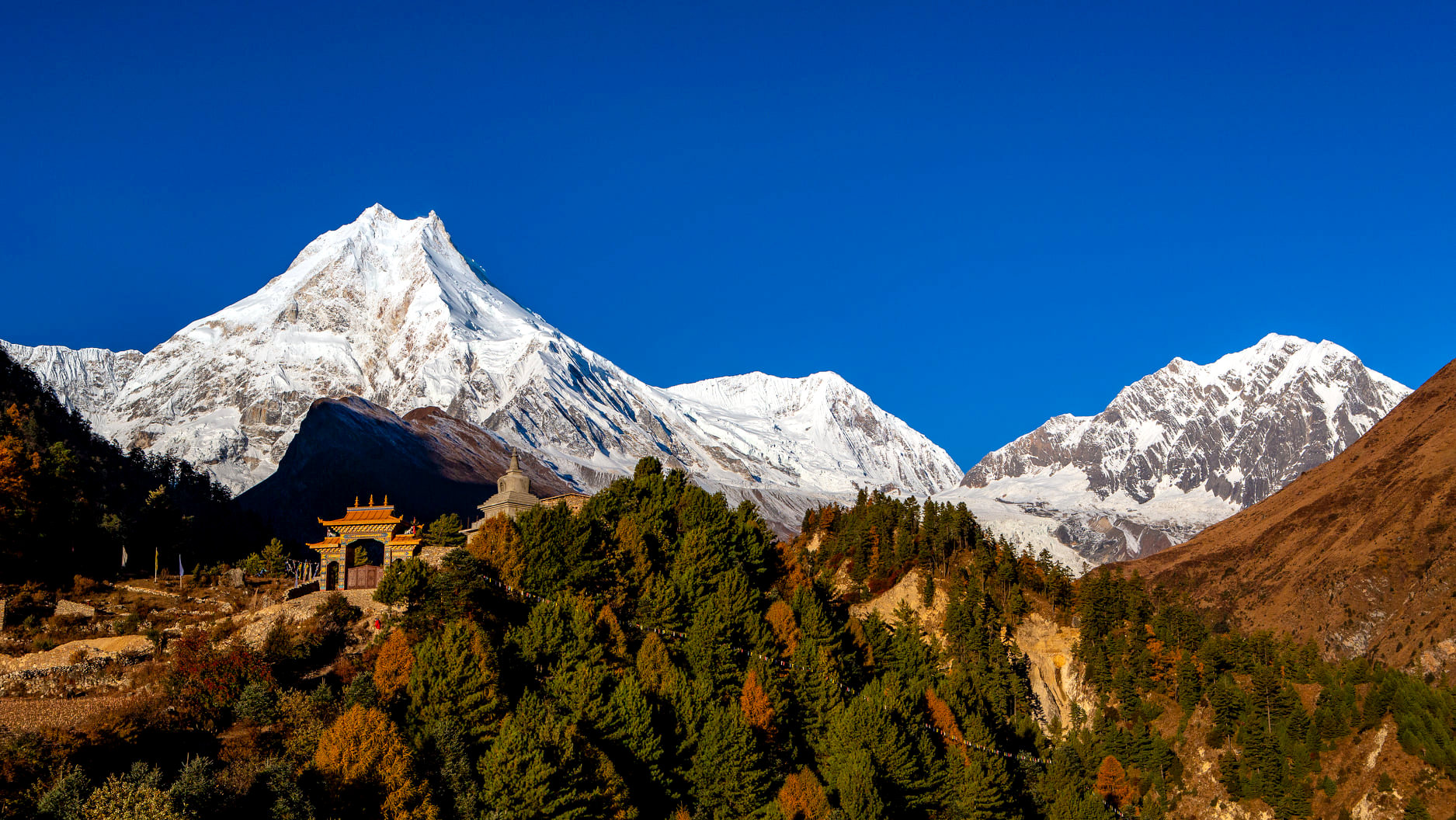
Highlights of the Manaslu Circuit Trek:
- Diverse Terrain: The trek starts from the subtropical jungle at lower elevations, winds through the Himalayan foothills, and culminates in the high, arid regions similar to the Tibetan Plateau. This diversity offers trekkers a remarkably varied hiking experience.
- Larkya La Pass: At an elevation of 5,106 meters (16,752 feet), crossing the Larkya La Pass is both a challenge and a highlight, providing stunning views of Manaslu and other Himalayan giants.
- Authentic Cultural Experiences: The Manaslu Circuit passes through ancient Buddhist villages where trekkers can experience rich cultural traditions, visit monasteries, and observe daily life that has remained largely unchanged for centuries.
- Flora and Fauna: The trek offers the chance to witness a variety of wildlife, including the elusive snow leopard, Himalayan Thar, and various species of birds. The forests are lush with rhododendrons and other alpine flowers, especially vibrant during the spring months.
- Manaslu Conservation Area: This protected area is home to a rich biodiversity and the trek provides an opportunity to explore this pristine environment responsibly.
Why the Manaslu Circuit Trek Stands Out: The Manaslu Circuit Trek is often compared to the Annapurna Circuit but is less crowded, offering a more secluded and authentic experience. The trek has gained popularity for its off-the-beaten-path feel, breathtaking scenery, and the opportunity to experience the stark natural beauty and cultural richness of the Himalayas.
Trekking Experience: The Manaslu Circuit Trek is considered challenging due to its high altitude, remote location, and the length of the trek. It requires good physical fitness and acclimatization to avoid altitude sickness. Trekkers need a special permit to access this restricted area, emphasizing the trek's exclusivity and commitment to preserving its natural and cultural integrity.
Embarking on the Manaslu Circuit Trek is an unforgettable adventure that offers not just physical challenges but also a profound journey into the heart of the Himalayas, where the magnificence of nature and the warmth of the local people create an enduring impact on those who traverse its paths.
Dolpo Region
The Dolpo Region, nestled in the remote corners of western Nepal, stands as a testament to the untouched and mystical allure of the Himalayas. This area, made famous by Peter Matthiessen's book "The Snow Leopard" and Eric Valli's film "Himalaya," remains one of the most isolated parts of Nepal, offering breathtaking landscapes, ancient cultures, and a serenity that is increasingly rare in today's world.
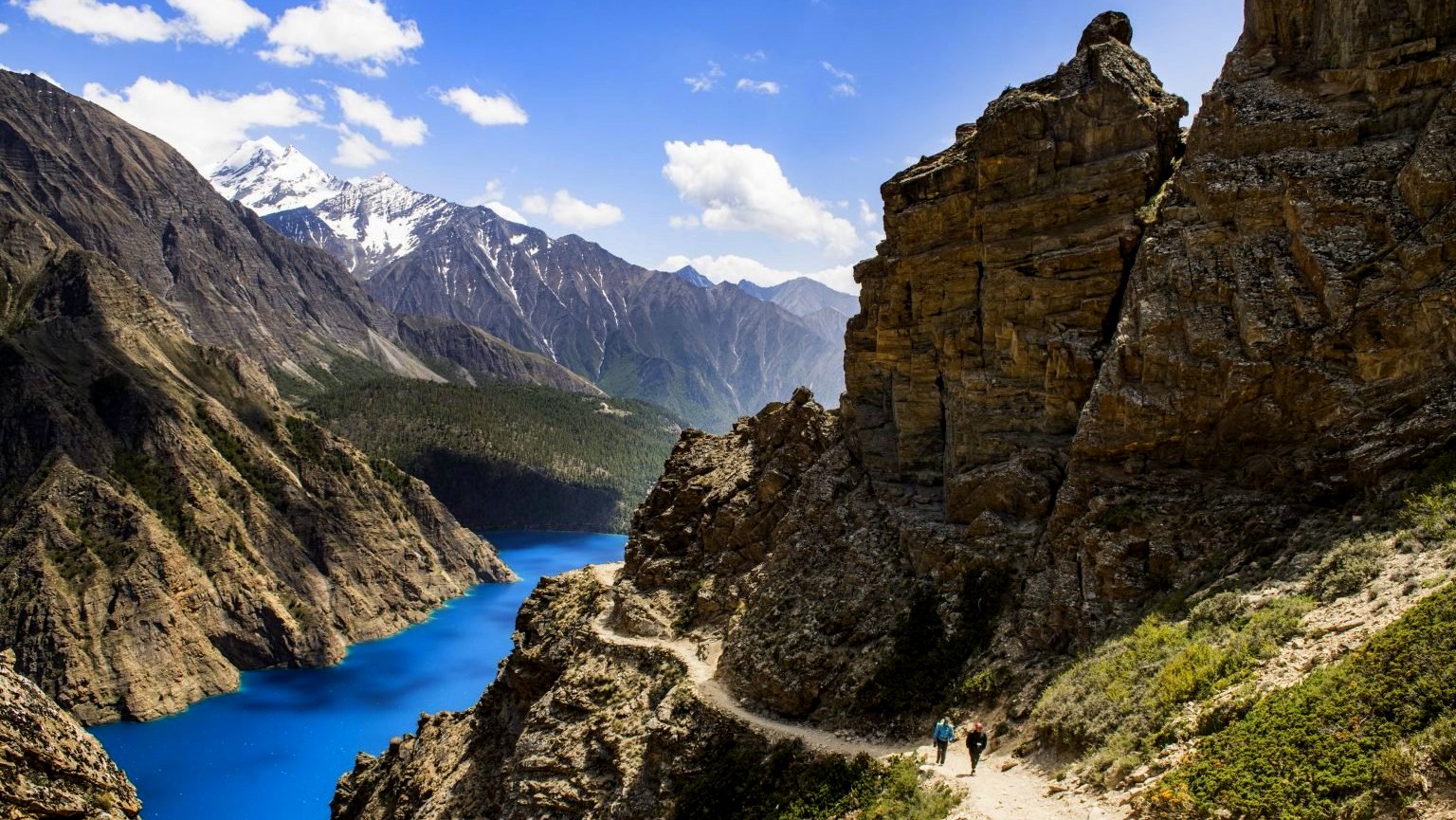
Highlights of the Dolpo Region:
- Shey Phoksundo Lake: Dolpo is home to the stunning Shey Phoksundo Lake, Nepal's deepest and arguably most beautiful lake, known for its turquoise waters and serene surroundings.
- Shey Gompa: Often referred to as the "spiritual heart" of Upper Dolpo, Shey Gompa is an ancient monastery located near the crystal-clear waters of Shey Phoksundo Lake, surrounded by dramatic mountain scenery.
- Phoksundo National Park: This park protects diverse ecosystems, rare flora and fauna, and offers trekkers a chance to witness the elusive snow leopard, as well as other wildlife like the blue sheep.
- Ancient Tibetan Culture: Dolpo has preserved its traditional Tibetan culture, largely due to its isolation. The region is dotted with ancient monasteries, chortens, and prayer flags, reflecting a lifestyle that has remained unchanged for centuries.
- Rugged and Remote Trails: The trekking routes in Dolpo traverse through some of the most remote and rugged terrains, offering adventurers an unparalleled sense of exploration and discovery.
Importance of the Dolpo Region: Dolpo's importance lies not only in its breathtaking natural beauty but also in its cultural richness. The region offers a glimpse into a way of life that has been preserved through the centuries, largely unaffected by the outside world. Its people, who live in some of the highest inhabitable villages in the world, practice Buddhism and Bon, an ancient animistic religion, adding to the area's mystical allure.
Trekking Experience: Trekking in the Dolpo region is a challenging yet rewarding experience. It requires a high level of fitness, as trekkers will navigate through tough terrains at altitudes exceeding 5,000 meters. The area's isolation means that trekkers must be fully self-sufficient, carrying all necessary supplies. Due to its remote location, trekking in Dolpo offers an unparalleled adventure that is becoming increasingly rare in the crowded trekking routes found elsewhere in Nepal.
The Dolpo region appeals to those seeking adventure beyond the conventional, offering a journey into a land where the beauty of nature and the depth of cultural traditions create a profound and unforgettable experience. Its restricted status ensures that the region remains pristine, making it a must-visit for trekkers looking to explore one of the last truly remote areas on Earth.
Tsum Valley
The Tsum Valley, nestled in the northern part of Gorkha district in Nepal, is a sacred Himalayan pilgrimage valley steeped in ancient history, rich in culture, and blessed with breathtaking natural beauty. This remote valley is surrounded by the Buddha Himal and Himal Chuli to the west, Ganesh Himal to the south, and Sringi Himal to the north, making it a true hidden gem within the Nepalese Himalayas. Known for its unique Tibetan Buddhist traditions, vibrant festivals, and stunning landscapes, the Tsum Valley offers a serene and spiritually enriching experience for trekkers.
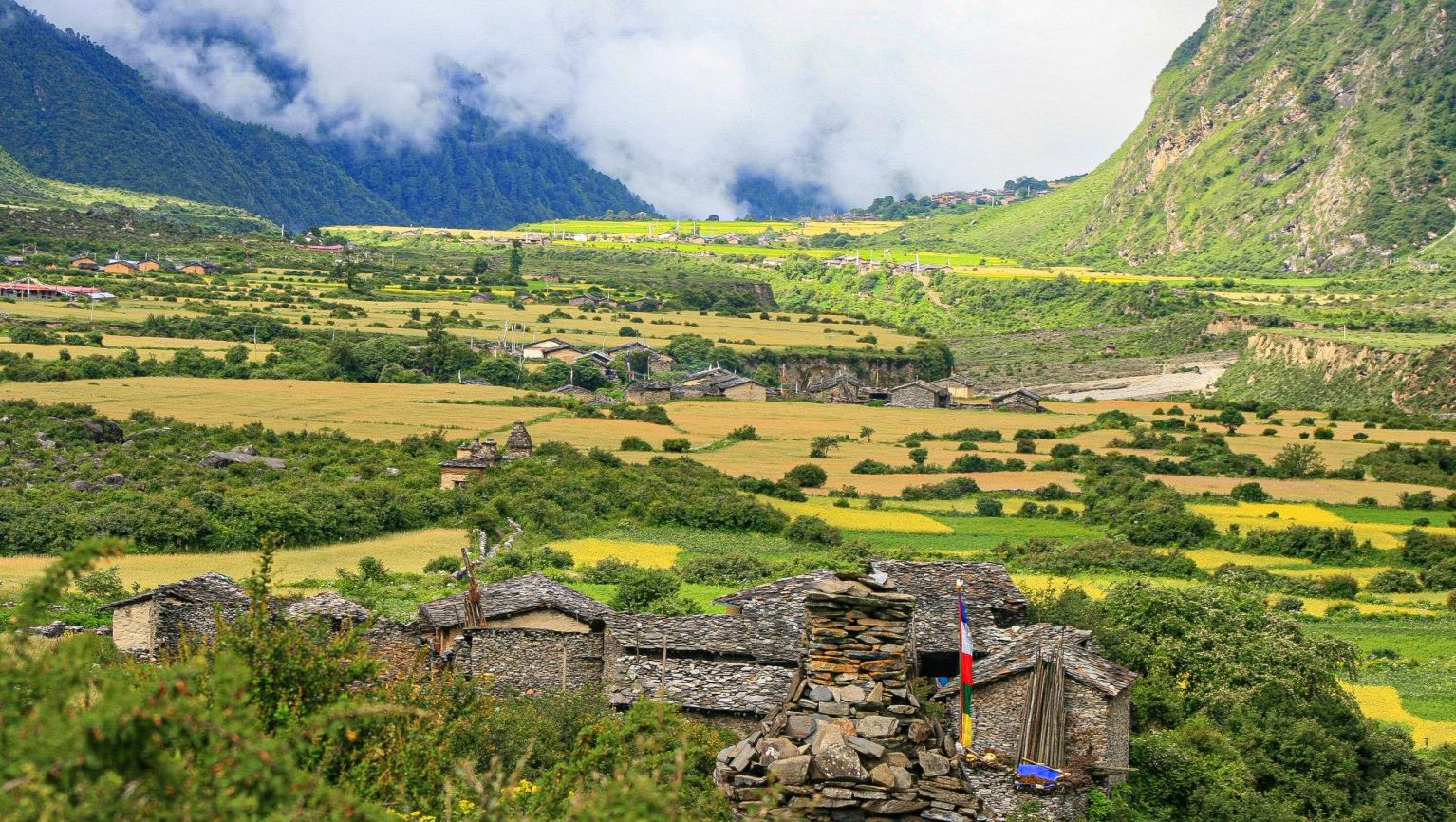
Highlights of Tsum Valley Trek:
- Rich Cultural Heritage: The valley is dotted with ancient monasteries, chortens, and mani walls. The most prominent among these is the Mu Gompa monastery, which is located at the highest point in the valley and serves as a testament to the region's rich Buddhist heritage.
- Spectacular Scenery: Tsum Valley offers an array of natural wonders, from lush forests and rushing rivers to high-altitude deserts and dramatic mountain vistas. The valley's isolation has preserved its pristine beauty, untouched by modern development.
- Unique Tibetan Buddhism: The people of Tsum Valley follow Tibetan Buddhism, and their customs and traditions are well preserved. Visitors can witness daily prayers, colorful murals, and ancient rituals that have been passed down through generations.
- Rare Wildlife: The region is part of the Tsum Valley Conservation Area, which aims to conserve the natural environment and the rare species that inhabit it, such as the Himalayan Thar and the snow leopard.
- Peaceful Trekking Experience: Unlike more popular trekking routes in Nepal, Tsum Valley sees fewer visitors, offering a peaceful and meditative trekking experience. The trails wind through quaint villages, past barley fields and under the shadow of towering peaks, providing a sense of solitude and tranquility.
Trekking Experience: Trekking to Tsum Valley is considered moderately difficult, with trails taking you through varied terrains at altitudes ranging from 1,900 to 3,700 meters. The trek typically starts and ends in Arughat or Sotikhola, extending into the border regions of Tibet. It can take around 18 to 19 days to complete, including acclimatization days to ensure trekkers can comfortably adjust to the high altitude.
The Tsum Valley trek is a journey into a world that time forgot, offering a blend of spiritual awakening, cultural immersion, and natural splendor. It’s an ideal trek for those looking to explore the less-traveled paths of Nepal, seeking a deeper connection with nature and Himalayan Buddhism.
Nar Phu Valley
The Nar Phu Valley, a hidden gem nestled in the shadows of the Annapurna and Manaslu ranges in Nepal, offers an extraordinary trekking experience for those looking to explore off the beaten path. This region, only opened to tourists in 2003, combines high peaks and passes, glaciers, remote villages, narrow canyons, lovely forests, amazing rock formations, yaks, gompas (monasteries), and unique Himalayan cultures. The blend of natural beauty and ancient culture, preserved through centuries of isolation, makes the Nar Phu Valley a captivating destination for adventurers and culture enthusiasts alike.
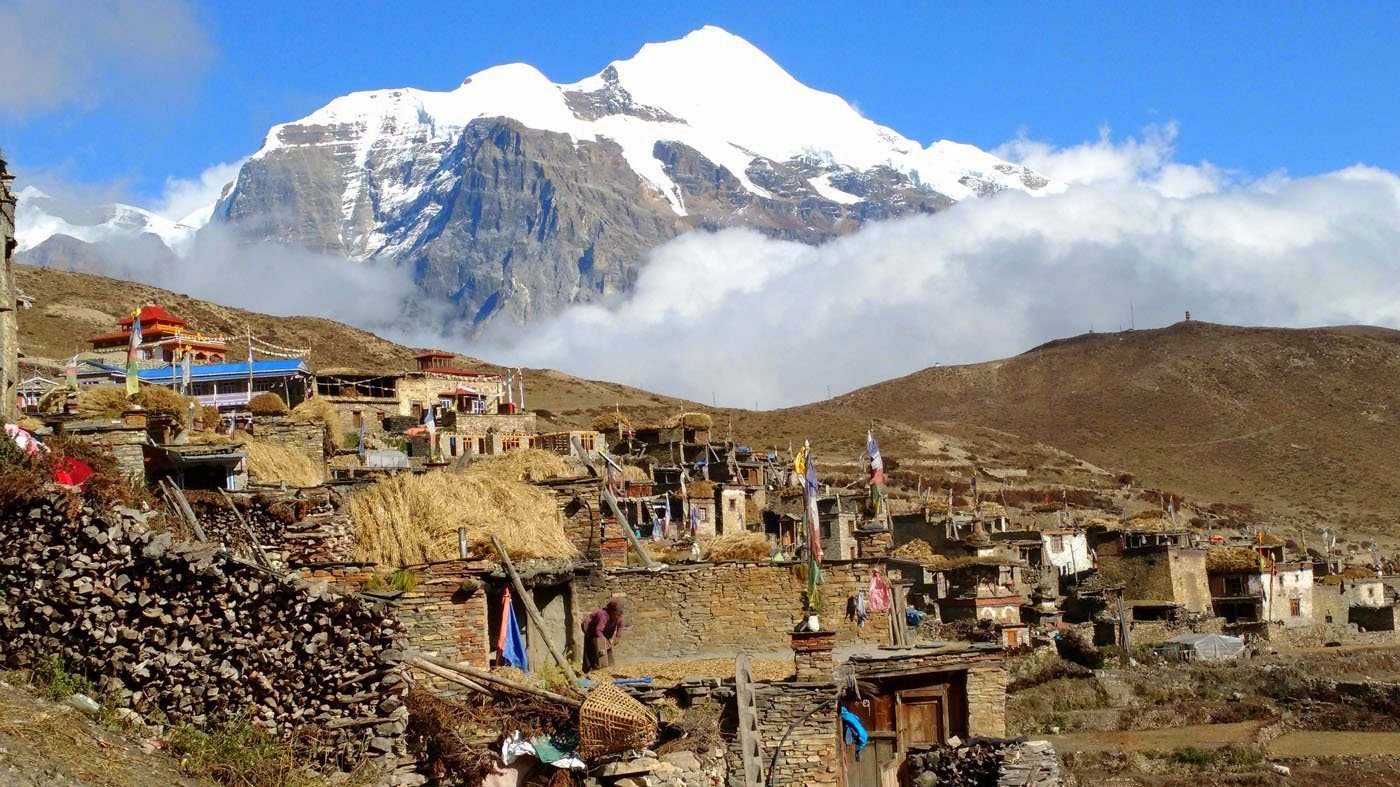
Highlights of the Nar Phu Valley Trek:
- Remote Villages: Nar and Phu, the two main villages of the valley, are traditional Tibetan villages with stone houses, where you can witness a way of life unchanged for centuries.
- Ancient Monasteries: The valley is dotted with ancient Buddhist monasteries, such as the Tashi Lhakhang Gompa, said to be established by the revered Buddhist guru, Padmasambhava (Guru Rinpoche).
- High Mountain Passes: The trek includes challenging passes like Kang La, which offers stunning views of the Annapurna massif and the Manaslu range.
- Unique Wildlife: The region's forests and highlands are home to endangered species like the snow leopard and the blue sheep, offering a rare glimpse into the diverse Himalayan fauna.
- Dramatic Landscapes: From narrow canyons to vast high-altitude plateaus, the valley's landscapes are dramatic and diverse, offering breathtaking scenery at every turn.
Importance of Nar Phu Valley: The Nar Phu Valley is a significant cultural treasure, offering insights into traditional Tibetan lifestyles and practices that have survived the test of time. Its isolation has preserved not only its culture but also its natural environment, making it a pristine area for trekking and exploration. The region’s unique geography and the local community’s way of life provide a fascinating contrast to the more visited areas of Nepal, offering a quiet and introspective trekking experience.
Trekking Experience: Trekking in the Nar Phu Valley is considered challenging due to its high altitude, remote location, and the need for crossing high passes. The trek is best suited for those who are physically fit and have some experience with high-altitude trekking. It requires special permits to enter, as the area is classified as a restricted region to help preserve its unique heritage and environment. Trekkers are rewarded with a profound sense of solitude, stunning natural beauty, and a deep cultural immersion that is hard to find in more accessible destinations.
The Nar Phu Valley trek is an opportunity to step back in time and experience the raw beauty of the Himalayas, combined with a rich cultural tapestry that enriches the soul. It's a journey that challenges the body, stimulates the mind, and touches the heart, leaving lasting memories of Nepal’s hidden valley.
Best Time to do Restricted Area Trekking in Nepal
The best time to undertake Restricted Area Trekking in Nepal is generally during the country's two main trekking seasons: spring (March to May) and autumn (September to November). These periods are favored due to their stable weather conditions, clearer skies, and moderate temperatures, providing the most favorable conditions for trekking in the high Himalayas. However, the ideal time can vary slightly depending on the specific region within Nepal's diverse terrain.
Spring (March to May)
Spring is a vibrant time of the year, with warmer weather gradually returning and the landscapes coming to life. It's an excellent time for trekking in the restricted areas for several reasons:
- Flora in Bloom: The trails and the surrounding landscapes are adorned with blooming rhododendrons and other wildflowers, adding spectacular colors to the trekking experience.
- Clear Skies: The visibility is generally good, offering stunning views of the Himalayan peaks.
- Mild Weather: Temperatures are comfortable for trekking, although it can still be quite cold at higher altitudes, especially in the early spring.
Autumn (September to November)
Autumn is perhaps the most popular trekking season in Nepal due to its clear skies, stable weather, and moderate temperatures.
- Best Visibility: After the monsoon season, the air is clean and fresh, offering the clearest views of the mountains.
- Cultural Festivals: This season coincides with several Nepalese festivals, providing trekkers with an opportunity to experience Nepal's rich cultural heritage.
- Stable Weather: The weather is stable, with little to no rain, making it ideal for high-altitude treks.
Off-Peak Seasons
- Summer/Monsoon (June to August): Trekking in restricted areas during the monsoon can be challenging due to heavy rains, landslides, and leeches. However, regions like Upper Mustang and Dolpo fall in the rain shadow of the Himalayas and are less affected by the monsoon, making summer a viable option for these areas.
- Winter (December to February): Winter trekking is possible but can be harsh due to cold temperatures and snow, particularly at higher altitudes. Some trails and passes may be inaccessible.
Considerations
When planning a trek in the restricted areas of Nepal, it's crucial to consider the specific climate and conditions of the targeted region. Some areas, especially those in the rain shadow, may offer unique trekking opportunities outside of the peak seasons. Regardless of when you go, it's essential to be well-prepared for changing weather conditions and to have flexible travel plans. Always check for the latest travel advisories and permit requirements, as regulations for restricted areas can change.
Essential tips for doing Restricted Area Trekking in Nepal
Trekking in the restricted areas of Nepal offers an unparalleled opportunity to explore some of the most remote and untouched landscapes on Earth. However, due to the unique challenges and regulations associated with these regions, trekkers should consider several essential tips to ensure a safe, enjoyable, and respectful journey.
Obtain Necessary Permits
- Research and Secure Permits Early: Each restricted area requires specific permits, which can only be obtained through registered trekking agencies in Nepal. Start this process well in advance of your trip to ensure all paperwork is in order.
Choose a Reputable Trekking Agency
- Experienced Guides and Porters: Since individual trekking is often not allowed in these areas, choosing a reputable agency with knowledgeable guides and responsible porters is crucial. They can navigate the challenging terrain and provide insights into local cultures and traditions.
Acclimatize Properly
- Plan for Acclimatization Days: High altitude sickness is a significant risk. Incorporate acclimatization days into your itinerary to allow your body to adjust to the altitude gradually.
Pack Appropriately
- Essential Gear and Clothing: Pack layers for varying temperatures, a good quality sleeping bag, a sturdy pair of trekking boots, and any personal medication. Also, include solar chargers or spare batteries, as electricity can be scarce.
Respect Local Customs and Traditions
- Cultural Sensitivity: Learn about and respect the local customs, traditions, and religious practices. Dress modestly, ask permission before taking photographs of people, and show respect at religious sites.
Stay Environmentally Conscious
- Leave No Trace: Minimize your environmental impact by carrying out all trash, using water purification methods instead of buying bottled water, and staying on established trails.
Prepare for Limited Connectivity
- Expect to Disconnect: Many restricted areas have little to no cell phone or internet connectivity. Prepare to be out of touch with the outside world during your trek.
Invest in Travel Insurance
- Comprehensive Coverage: Ensure your travel insurance covers high-altitude trekking, medical evacuation, and any other potential risks associated with your trek.
Be Physically and Mentally Prepared
- Pre-Trek Training: The treks can be physically demanding. Engage in cardiovascular exercises, strength training, and hiking to prepare your body. Mental preparation is also crucial for dealing with the challenges and isolation of remote trekking.
Understand the Itinerary and Conditions
- Research: Familiarize yourself with the trek's itinerary, the conditions you'll face, and the level of difficulty. Knowing what to expect each day can help you better prepare and enjoy the trek.
Be Flexible
- Expect the Unexpected: Weather conditions, health issues, or other unforeseen circumstances can change your itinerary. Being flexible and open to adjustments is key.
By following these essential tips, trekkers can navigate the complexities of restricted area trekking in Nepal, ensuring a memorable and enriching experience that respects both the natural environment and the local communities encountered along the way.
Restricted Area Trekking in Nepal offers an extraordinary adventure into some of the most pristine and culturally rich landscapes on Earth. By embracing the challenges and respecting the regulations of these secluded regions, trekkers are rewarded with unparalleled experiences—breathtaking natural beauty, ancient cultures, and the rare chance to explore the untouched corners of the Himalayas. Preparing thoroughly, respecting local customs, and choosing responsible trekking practices ensure not only a memorable journey but also contribute to the preservation and appreciation of these unique environments and communities. Whether crossing high mountain passes, exploring ancient monasteries, or witnessing the daily life of remote Himalayan villages, the essence of adventure in Nepal's restricted areas lies in the profound connection trekkers forge with nature and culture, making it an unforgettable expedition into the heart of the wild.
FAQs of the Restricted Area Trekking in Nepal
Q: What are restricted areas in Nepal?
A: Restricted areas in Nepal are regions regulated by the government to protect their natural environment, preserve local cultures, and due to geopolitical reasons. These areas offer unique trekking experiences with their distinct landscapes and cultures.
Q: Why are these areas restricted?
A: These areas are restricted to manage the impact of tourism, ensuring sustainable travel practices and the protection of both the environment and the local cultures.
Q: How can I obtain a permit for restricted area trekking?
A: Permits can only be obtained through a registered Nepalese trekking agency, which will handle all necessary paperwork. Individual trekkers cannot apply for these permits on their own.
Q: What documents are needed for the permit?
A: You will typically need a valid passport, visa, and sometimes additional documentation as specified by the trekking agency. Requirements may vary based on the specific restricted area.
Q: Can I trek alone in these restricted areas?
A: No, trekking alone is not allowed. You must be part of a group and accompanied by a licensed guide, with specific group size and guide requirements varying by region.
Q: What is the best time to trek in these areas?
A: The best times are the pre-monsoon spring months (March to May) and the post-monsoon autumn months (September to November), though some areas are suitable for summer trekking due to their unique climate.
Q: How difficult are treks in restricted areas?
A: Difficulty varies but can range from moderate to challenging, involving high altitudes, rugged terrain, and remote locations. Good physical fitness and proper acclimatization are essential.
Q: What should I pack for a trek in a restricted area?
A: Essentials include layered clothing, a quality sleeping bag, sturdy trekking boots, a first-aid kit, personal medications, and water purification tablets. Your agency will provide a detailed list based on your specific trek.
Q: Are there any cultural considerations I should be aware of?
A: Yes, it's crucial to respect local customs and traditions. Dress modestly, ask for photo permissions, avoid public displays of affection, and show respect at religious sites.
Q: Is travel insurance necessary?
A: Absolutely. Ensure your insurance covers high-altitude trekking, medical evacuation, and any other planned activities. Verify that it is valid for the altitudes you will be trekking to.
If you need any further information, please contact us by email: at [email protected], Phone: at +977- 985 100 5129 (WhatsApp)




